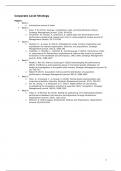Corporate Level Strategy
Papers:
Week 1
o Introduction lecture & slides
Week 2
o Zhou, Y. M. (2011). Synergy, coordination costs, and diversification choices.
Strategic Management Journal, 32(6), 624-639
o Schommer, M., Richter, A. and Karna, A. (2019) Does the diversification–firm
performance relationship change over time? A meta-analytical review. Journal of
Management Studies, 56: 270-298
Week 3
o Stettner, U., & Lavie, D. (2014). Ambidexterity under scrutiny: Exploration and
exploitation via internal organization, alliances, and acquisitions. Strategic
Management Journal, 35(13), 1903-192
o Castañer, X., Mulotte, L., Garrette, B., and Dussauge, P. (2014). Governance mode
vs. governance fit: Performance implications of make-or-ally choices for product
innovation in the worldwide aircraft industry, 1942–2000. Strategic Management
Journal, 35(9), 1386-1397
Week 4
o Moatti V, Ren CR, Anand J, Dussauge P (2015) Disentangling the performance
effects of efficiency and bargaining power in horizontal growth strategies: An
empirical investigation in the global retail industry Strategic Management Journal 36
(5), 745-757
o Rabier M (2017). Acquisition motives and the distribution of acquisition
performance. Strategic Management Journal 38(13): 2666-2681
Week 5
o Chen, G., Crossland, C., & Huang, S. (2016). Female board representation and
corporate acquisition intensity. Strategic Management Journal, 37(2), 303-313
o Shi, W., Zhang, Y., & Hoskisson, R. E. (2017). Ripple effects of CEO awards:
Investigating the acquisition activities of superstar CEOs' competitors. Strategic
Management Journal, 38(10), 2080-2102
Week 6
o Vidal, E., & Mitchell, W. (2015). Adding by subtracting: The relationship between
performance feedback and resource reconfiguration through divestitures.
Organization Science, 26(4), 1101-1118
o Feldman, E. (2014) Legacy Divestitures: Motives and Implications. Organization
Science 25(3):815-832
1
,Week 1: Introduction class
What is corporate strategy?
Corporate vs. business strategy
The corporate growth trap
‘We must expand, we must purse size, we must grow at any costs, because if we are
bigger, we’ll be more profitable’
There is no systematic link between the size and profitability of a multi-business firm
Corporate growth aims at increasing corporate profits and profitability not at increasing
corporate sales ‘per se’
What is corporate strategy about?
1. Where?
2. How?
3. Why?
1. Where?
2
, Business Development (BD)
o More of extant activities
Horizontal expansion (HE)
o Combining extant activities with new activities
o Varying levels of relatedness
Vertical Expansion (VE)
o Internal production of activities formerly
outsourced to specialized firms
Forward VE: Zara: from raw materials to
stores
Backward VE: Total: from oil distribution
to oil exploration
Backward vertical integration/expansion
Moving up the value chain
Forward vertical integration/expansion
Moving down the value chain:
Unrelated horizontal diversification
E.g., from aircraft to pizza
Examples
Criteria to judge, usually 5
1. Technology the same?
2. Suppliers the same?
3. Competitors
4. Buyers
5.
Previous relationship means vertical integration
For vertical integration means that before the transaction you are supposed/could have worked with
a supplier, so you could have a market relationship
2. How?
Build
o Greenfields
o Corporate venturing
o Internal development
o Exports
Blend
o Alliances & JVs
o Equity sharing
o Technology partnerships
Buy
o Mergers & acquisitions
o Technology licensing
o Franchising
The ‘corporate expansion matrix’
3
, 3. Why?
Decreased input cost
Refers to economies from procurement, when purchasing in bulk.
Decreased production cost
Refers to scale economies or scope economies. Offsetting fixed cost on greater volumes.
The Grand Challenge
Logics for corporate growth
Logics for Corporate Growth
4





